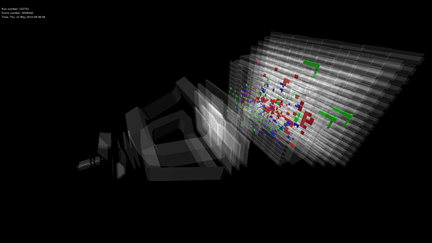Today, proton beams collided at 13 TeV for the first time inside the LHCb detector. The collisions were part of the ongoing accelerator tests, and are not useful for physics studies. The collected data are, however, useful for refining the synchronization of the readout time of different parts of the calorimeters and muon detectors. The image displays an event taken today.
These collisions were the latest in a sequence of careful steps to prepare the LHC for physics operation at 13 TeV. Proton beams first circulated again after a two year long shutdown on the 5th April, and collided at the relatively low energy of 450 GeV on the 5th May. First collisions for physics studies, in so-called “Stable Beams” conditions, are expected in early June.
A new LHCb sub-detector, HeRSCheL, also collected today its first proton-proton collisions data. HeRSCheL, a system of forward shower counters, was installed during the two-year shutdown for distinguishing between processes where the interacting proton in the beam remains undetected passing down the beampipe with no activity recorded in HerScheL and processes in which a signal is observed. It consists of several stations, like the one shown in the video, located around the LHC beam pipe in the accelerator tunnel on both sides of the LHCb detector. It is interesting to note that some of these detectors are over 100m away from LHCb, but still see particles from the same collision.
Click the image for higher resolution. Read more in the CERN news.

